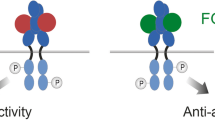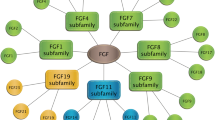Summary
We investigated the regulation of expression of bFGF and aFGF in cultures of normal human dermal fibroblasts grown in a defined, serum-free medium which did not contain FGF. Under these conditions we detected three molecular weight forms of bFGF protein [18.0, 23.0, and 26.6 kiloDaltons (kD)] and three molecular weight forms of aFGF protein (18.4, 19.2, and 28.6 kD) in these cells using western blot analysis. The addition of fetal bovine serum (FBS) to these cultures caused an accumulation of all three molecular weight forms of bFGF protein with a more dramatic accumulation of the 23.0 and 26.6 kD forms. In contrast, the addition of FBS to the cultures had no effect on the level of aFGF proteins. Analysis of mRNA isolated from cells grown in serum-free medium revealed multiple species of both bFGF and aFGF RNA with molecular weights that correlated with our previous observations. The abundance of all bFGF mRNA species increased dramatically after serum treatment while the abundance of aFGF mRNA species increased only slightly. Our observations demonstrate that factor(s) present in FBS elevate the levels of bFGF mRNA and protein beyond the levels already present in the cultures growing in serum-free medium. Moreover, both bFGF and aFGF protein are present in these cells as multiple molecular weight species. Some of these forms are higher in apparent molecular weight than would be predicted from ATG-initiated primary translation products of these genes. We also show that the cells used for this study proliferate in response to bFGF and aFGF, thus, it is possible that the growth of these cells could be subject to autocrine/paracrine control in certain conditions.
Similar content being viewed by others
References
Abraham, J. A.; Whang, J. L.; Tumolo, A., et al. Human basic fibroblast growth factor: nucleotide sequence and genomic organization. EMBO 5(10):2523–2528; 1986.
Burgess, W. H.; Maciag, T. The heparin-binding (fibroblast) growth factor family of proteins. Ann. Rev. Biochem. 58:575–606; 1989.
Chiu, I. M.; Wang, W. P.; Lehtoma, K. Alternative splicing generates two forms of mRNA coding for human heparin-binding growth factor 1. Oncogene 5(5):755–762; 1990.
Cook, P. W.; Coffey, R. J.; Magun, B. E., et al. Expression and regulation of mRNA coding for acidic and basic fibroblast growth factor and transforming growth factor type-alpha in cells derived from human skin. Mol. Endo. 4:1377–1385; 1990.
Crumley, G.; Dionne, C. A.; Jaye, M. The gene for human acidic fibroblast growth factor encodes two upstream exons alternatively spliced to the first coding exon. Biochem. Biophys. Res. Comm. 171(1):7–13; 1990.
Danielson, P. E.; Forss-Petter, S.; Brow, M. A. plB15: a cDNA clone of the rat mRNA encoding cyclophilin. DNA 7:261–267; 1988.
Florkiewicz, R. Z.; Sommer, A. Human basic fibroblast growth factor gene encodes four polypeptides: three initiate translation from non-AUG codons. Proc. Natl. Acad. Sci. USA 86:3978–3981; 1989.
Goustin, A. S.; Leof, E. B.; Shipley, G. D., et al. Growth factors and cancer. Cancer Res. 46:1015–1029; 1986.
Hammond, S. L.; Ham, R. G.; Stampfer, M. R. Serum-free growth of human mammary epithelial cells: rapid clonal growth in defined medium and extended serial passage with pituitary extract. Proc. Natl. Acad. Sci. USA 81:5435–5439; 1984.
Klagsbrun, M.; Smith, S.; Sullivan, R., et al. Multiple forms of basic fibroblast growth factor: amino-terminal cleavages by tumor cell-and brain cell-derived acid proteinases. Proc. Natl. Acad. Sci. USA 84:1839–1843; 1987.
Kozak, M. Point mutations define a sequence flanking the AUG initiator codon that modulates translation by eukaryotic ribosomes. Cell 44:283–292; 1986.
Marcis, I.; Adelaide, J.; Raybaud, F., et al. Characterization of the HST-related FGF.6 gene, a new member of the fibroblast growth factor family. Oncogene 4:335–340; 1989.
McKeehan, W. L.; Crabb, J. W. Isolation and characterization of different molecular and chromatographic forms of heparin-binding growth factor 1 from bovine brain. Anal. Biochem. 164:563–569; 1987.
McNeil, P. L.; Muthukrishnan, L.; Warder, E., et al. Growth factors are released by mechanically wounded endothelial cells. J. Cell Biol. 109:811–822; 1989.
Melton, D. A.; Kreig, P. A.; Rebagliati, M. R. Efficient in vitro synthesis of biologically active RNA and RNA hybridization probes from plasmids containing a bacteriophage SP6 promoter. Nucleic Acids Research 12(18):7035–7056; 1984.
Mergia, A.; Tischer, E.; Graves, D., et al. Structural analysis of the gene for human acidic fibroblast growth factor. Biochem. Biophys. Res. Comm. 164(3):1121–1129; 1989.
Milner, P. G.; Li, Y. S.; Hoffman, R. M., et al. A novel 17 kD heparinbinding growth factor (HBGF-8) in bovine uterus: purification and N-terminal amino acids sequence. Biochem. Biophys. Res. Comm. 165(3):1096–1103: 1989.
Moscatelli, D.; Joseph-Silverstein, J.; Manejias, R., et al. Mr 25,000 heparin-binding protein from guinea pig brain is a high molecular weight form of basic fibroblast growth factor. Proc. Natl. Acad. Sci. USA 84:5778–5782; 1987.
Moscatelli, D.; Joseph-Silverstein, J.; Presta, M. Multiple forms of an angiogenesis factor: basic fibroblast growth factor. Biochimie 70:83–87; 1988.
Prats, H.; Kaghad, M.; Prats, A. C., et al. High molecular mass forms of basic fibroblast growth factor are initiated by alternative CUG codons. Proc. Natl. Acad. Sci. USA 86:1836–1840; 1989.
Presta, M.; Rusnati, M.; Maier, J., et al. Purification of basic fibroblast growth factor from rat brain: identification of a mr 22,000 immunoreactive form. Biochem. Biophys. Res. Comm. 155(3):1161–1172; 1988.
Renko, M.; Quarto, N.; Morimoto, T., et al. Nuclear and cytoplasmic localization of different basic fibroblast growth factor species. J. Cell. Physiol. 144:108–114; 1990.
Schweigerer, L.; Neufeld, G.; Friedman, J., et al. Basic fibroblast growth factor: production and growth stimulation in cultured adrenal cortex cells. Endocrinology 120:796–800; 1987.
Shipley, G. D.; Keeble, W. W.; Hendrickson, J. E., et al. Growth of normal human keratinocytes and fibroblasts in serum-free medium is stimulated by acidic and basic fibroblast growth factor. J. Cell. Physiol. 138:511–518; 1989.
Shipley, G. D. A serum-free [3H]thymidine incorporation assay for detection of transforming growth factors. J. Tiss. Cult. Meth. 10(2):117–124; 1986.
Sternfeld, M. D.; Hendrickson, J. E.; Keeble, W. W., et al. Differential expression of mRNA coding for heparin-binding growth factor type 2 in human cells. J. Cell. Physiol. 136:297–304; 1988.
Story, M. T. Cultured human foreskin fibroblasts produce a factor that stimulates their growth with properties similar to basic fibroblast growth factor. In Vitro Cell. Dev. Biol. 25(5):402–408; 1989.
Thomas, K. A. Fibroblast growth factors. FASEB 1:434–440; 1987.
Wang, W.; Lehtoma, K.; Varban, M., et al. Cloning of the gene coding for human class I heparin-binding growth factor and its expression in fetal tissues. Mol. Cell. Biol. 9(6):2387–2395; 1989.
Author information
Authors and Affiliations
Rights and permissions
About this article
Cite this article
Root, L.L., Shipley, G.D. Human dermal fibroblasts express multiple bFGF and aFGF proteins. In Vitro Cell Dev Biol - Animal 27, 815–822 (1991). https://doi.org/10.1007/BF02631248
Accepted:
Issue Date:
DOI: https://doi.org/10.1007/BF02631248




